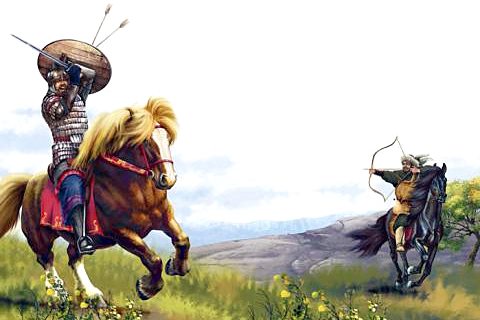
Battle of Diakene(Battle of Ekato Vounoi) |
year: 1050 |
| Defeat of a large Byzantine army by the Pechenegs | ★ ★ ★ ★ ★ |
|
enemy: Pechenegs
|
location: At the location “Ekato Vounoi” or “Diakene” at NE Bulgaria, north of the Haemus mountains
|
accuracy:
●●●●●
|
|
battle type: Pitched Battle |
war: Pecheneg Wars |
modern country:
Bulgaria |
| ▼ The Byzantines(emperor: Constantine IX Monomachos) | ▼ The Enemies | |
| Commander: | Rhector Nikephoros | Khan Tyrach |
| Forces: | ||
| Losses: |
| Background story: |
| In 1049, a large population of Pechenegs (perhaps 800,000) were settled, with the tolerance of the Byzantines (initially), in the area around Serdiki (present-day Sofia, Bulgaria). From there, ignoring the intentions of Byzantium to Christianize them and integrate them into the empire, they launched attacks against Macedonia and Thrace. The first attempt of the Byzantines to react to this turn of events was made by the commander of the Western forces magistros Constantine Arianitis, who marched against them from Adrianople, but suffered a heavy defeat near Diampolis and retreated to Adrianople from where he requested reinforcements from Constantinople. Emperor Constantine IX Monomachos responded immediately to the request and organized an army consisting of units of the regular army of the East. At the same time, he decided to use the khan of the Pechenegs Tyrah, who was being held hostage in Constantinople. After receiving promises from Tyrach and the other Pecheneg hostages that they would help solve the problem (in return for a generous reward), he sent them to take part in the campaign in northern Thrace. |
The Battle: |
 A eunuch named Nikephoros, who had no military experience, was appointed leader. He used to be a priest and then he became a servant of Monomachos. The emperor gave him the title of rhector and entrusted him with the command of this important campaign (this make sense only because the emperor had very bad relationships with the top generals who despised him). In 1050, the Byzantine army marched north and passed through the Iron Gates on the eastern side of the Aimos mountain range (a passage that is probably the Riski pass) and was found at the location “Ekato Vounoi” (meaning “one hundred mountains”) or “Diekene”. The place has not been identified, but must have been somewhere between Aimos and the Danube, in northeastern Bulgaria. At Ekato Vounoi the imperial army encamped preparing for attack. Tyrach and the other hostages stepped forward to talk to their fellow men, but instead of trying to persuade them to surrender, they joined them and turned against the Byzantines. Nikephoros decided to give battle the next day, being sure of the victory and having the only concern lest any of the enemies escape. The Pechenegs not only were not afraid of the strong Byzantine army, but they started galloping near the Byzantine positions, challenging the opponents to battle. Kekavmenos, seeing the Pechenegs scattered and disorganized, considered it a very good opportunity and suggested to Nikephoros to attack immediately. Nikephoros rejected the idea on the grounds that the Pechenegs would take refuge in the woods and would not be easy to find them without hunting dogs(!) So tha battle took place the next day. Nikephoros was at the center of the Byzantine formation. Kekavmenos was on the right wing and Frangopoulos on the left. Shortly after the start of the battle, under the pressure of the Pechenegs, Nikephoros was the first to flee. Seeing their leader running, the rest of the army began to retreat in disorder. Kekavmenos was left behind alone with few of his men, but was seriously injured. The victors plundered the Byzantine camp, obtaining large booty. The defeated Byzantine army returned to Adrianople. |
Noteworthy: |
| During the battle, Kekavmenos was seriously wounded in the head. A Pecheneg who took part in the looting of the battlefield found him and recognized him. He secretly took him to his tent and treated his wounds. Kekavmenos became well and then somehow (perhaps by paying a ransom) managed to returned to Byzantium and continued to offer his services to the Byzantine army. |
Aftermath: |
| The war with the Pechenegs continued in the following years. They dominated northern Thrace and Bulgaria. The Byzantines suffered more defeats. This lasted until 1053 when a peace treaty was agreed. |
|
|
